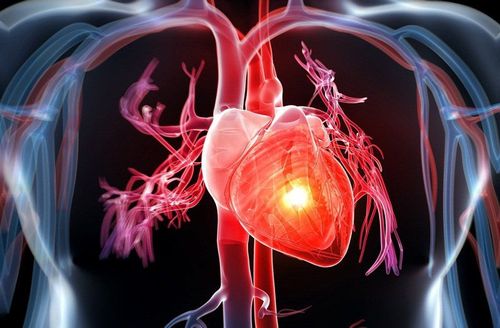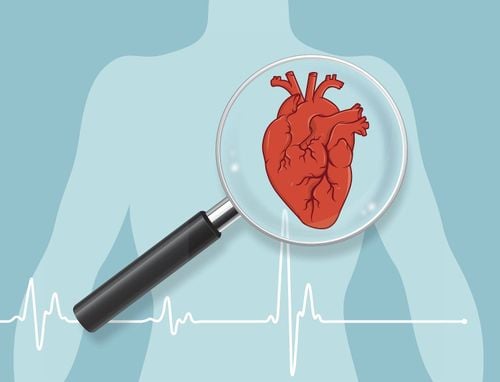This is an automatically translated article.
The article is professionally consulted by Master, Doctor Bui Tien Dat - Emergency Medicine - Cardiology - Emergency Resuscitation Department - Vinmec Hai Phong International General Hospital. The doctor has more than 12 years of experience in the field of emergency resuscitation - cardiology.Cardiovascular emergency accounts for a high rate next to other emergency respiratory and cerebral strokes. Cardiovascular emergencies are always serious emergencies, requiring emergency doctors to quickly diagnose and promptly and accurately handle common syndromes in cardiovascular emergencies in order to save patients' lives and achieve effective results. high results in treatment.
1. Cardiovascular collapse syndrome
1.1 Causes of cardiovascular collapse Cardiovascular collapse is caused by a sudden and rapid decline in circulatory function, including:Circulatory arrest, cardiac arrest Decompensated or compensated shock 1.2 Treatment of cardiovascular collapse in Cardiovascular emergency Approach to treatment according to existing guidelines:
Percutaneous coronary intervention is recommended in patients with life-saving cardiac arrest and electrocardiogram with ST-segment elevation myocardial infarction. Temperature control is indicated for patients in cardiac arrest whose life is saved but whose neurological function has not been improved. It is essential to establish a healthcare system with professional staff that can detect ST-segment elevation myocardial infarction patients and promptly refer them to a center capable of 24/7 reperfusion. . All healthcare professionals caring for patients with suspected myocardial infarction should have access to defibrillation equipment and training in basic cardiac arrest. Emergency coronary angiography (and intervention if indicated) for patients in life-saving cardiac arrest without an ST-segment elevation myocardial infarction but at high risk for myocardial ischemia. Rapid and large intravenous infusion of cold solutions is not recommended in patients after spontaneous circulation has been restored. 1.3 Notes on management of heart failure syndrome Priority: Maintain airway and provide adequate oxygen; ensure adequate perfusion to maintain the vital organs of the heart and brain.
When the situation is stabilized: quickly find and solve the causes early.
Reperfusion is indicated in all patients with onset of symptoms of myocardial ischemia 12 hours and persistent ST elevation

2. Acute chest pain syndrome
2.1 Causes of acute chest pain syndrome Serious, life-threatening conditions:Acute coronary syndromes; Separation of the aortic wall; Pulmonary infarction; Pneumothorax ; Pericardial effusion presses the heart; Mediastinal pathology (eg, ruptured esophagus...). Common condition:
Causes from heart, pericardium; Causes from the lungs, pleura; Chest wall, muscle, bone; Digest. Some other causes: systemic disease, paraneoplastic disease, herpes zoster...
2.2 Clinical examination Assess vital signs including: blood pressure, heart rate, breathing rate...
Identify other causes Cardiovascular signs: pericardial rub, heart sound, abnormal murmur, loss of pulse or weak pulse.
Assess lung status: abnormal rales, signs of pneumothorax, pleural effusion.
Abnormal chest wall signs
Neurological signs: focal paralysis (aortic dissection....)
Diagnostic approaches:
12-lead electrocardiogram; Blood tests: Cardiac biomarker (TnT; CK-MB...), D-Dimer, BNP; chest X-ray; Acute echocardiography ; CT scan. 2.3 Management of acute chest pain in cardiovascular emergencies Detailed examination of medical history and medical history. Rapid assessment and stabilization of vital functions.
Having an electrocardiogram monitor; 12-lead electrocardiogram, monitoring within 10 minutes; Breathe oxygen; Pain relief; Place an intravenous line; Take blood to test troponin, blood sugar, electrolytes, evaluate kidney function; Possible considerations for use: aspirin, nitroglycerin, analgesic: morphine. 2.4 Notes when dealing with acute chest pain in cardiovascular emergencies If there is a right ventricular myocardial infarction should not use morphine or vasodilator drugs such as nitroglycerin. For early analgesia, use a pain scale of 0-10 points. Ask the patient to rate their own pain from 0 (no pain) to 10 (most severe pain). Monitor Sp02, electrocardiogram, measure blood pressure several times.
3. Acute dyspnea syndrome
3.1 Causes of acute dyspnea Cardiovascular causes:Acute left ventricular failure; Acute hemodynamic pulmonary edema; Acute coronary syndrome; Severe decompensated valvular disease; Severe arrhythmias; Acute pericardial disease (cardiac tamponade); Cardiomyopathy; Pulmonary infarction; Pulmonary hypertension (acute exacerbation). Non-cardiovascular causes:
Respiratory system disease: foreign body, acute laryngitis... Lung disease: COPD exacerbation, asthma, pneumonia, pneumothorax, pleural fluid; Nervous system diseases: cerebrovascular accident, muscle paralysis, spinal cord paralysis; Metabolic pathology associated with poisoning; Some other reasons. 3.2 Clinical examination Vital signs (pay attention to respiratory rate)
Chest/lungs
Cardiac examination: murmur, pericardial rub
Other systemic signs:
Cyanosis Drumstick fingers. Laboratory investigations:
Straight chest X-ray Electrocardiogram 12-lead Electrocardiogram Biomarker of myocardium (TnT) Tests: ProBNP to rapidly rule out dyspnea due to heart failure or other pathology (pulmonary) Tests depending on other: D-Dimer; Blood gas; Echocardiography; CT scan... 3.3 Treatment of acute dyspnea in cardiovascular emergencies Principles of acute dyspnea in cardiovascular emergencies:
Provide adequate and optimal oxygen; Indication and availability of respiratory support when necessary (airway control and artificial ventilation); Quickly assess the cause for timely treatment. Steps to handle acute dyspnea in cardiovascular emergency:
Provide adequate oxygen; Establish an intravenous line for infusion of drugs and tests; Monitor oxygen saturation and cardiovascular parameters; Have airway control devices ready; Quickly assess the condition as well as the cause that can be resolved quickly (acute cardiac tamponade; pneumothorax; foreign body in the upper respiratory tract...). Attention to potentially life-threatening causes of acute dyspnea in cardiac emergencies.
4. Syncope syndrome

Arrhythmia: Ventricular tachycardia; Long QT syndrome; HC Brugada; Bradycardia: Mobitz II or BAV 3 atrioventricular block; sinus pause for less than 3 seconds; Ischemic Heart Disease: acute coronary syndrome; heart attack ; Cardiovascular structural diseases: Heart valves (HC; HHL); Cardiomyopathy (hypertrophy, dilatation); NT mucinous tumor; Cardiac tamponade; Split into aorta...; Pulmonary infarction. Syncope not due to Cardiovascular:
Major blood loss; Pulmonary infarction; Subarachnoid hemorrhage. The most common causes of syncope in cardiovascular emergencies are:
Causes related to sympathetic nervous system: Vasovagal. Situational syncope caused by coughing, swallowing, urinating (straining to urinate). Carotid sinus hypersensitive syndrome. Due to orthostatic hypotension leading to impaired autoregulation: primary, secondary (diabetes). Certain medications (lowering blood pressure). Circulatory volume loss. 4.2 Clinical examination Vital signs
Measurement of blood pressure, heart rate in standing and sitting positions
Examination of organs:
Thorough cardiac examination; Nerve system; Lungs (heart failure); Signs of internal bleeding. Paraclinical exploration:
12-lead electrocardiogram; Blood biochemical tests; Holter electrocardiogram; Echocardiography; Carotid sinus massage; Tilt table test; Electrophysiological examination of the heart. 4.3 Management of syncope in the cardiovascular emergency Syncope due to hypervagala: Loss of consciousness is usually less than 30 seconds. Usually unrelated to cardiovascular disease, predisposing factor, may be prodromal or motility (head rotation).
Conduct exploration by carotid sinus massage, tilt table NF. Treatment: conduct carotid sinus congestion using a 2-chamber pacemaker. Other vagal syncope: Lifestyle changes; exercise posture... Some drugs: beta-blockers; fludrocortisone, midodrine, and fluoxetine. Syncope due to orthostatic hypotension:
Definition: postural blood pressure falls below 20 mmHg after 3 minutes on standing or falls to <90 mmHg. Treatment: Cut off drugs that cause hypotension; health education; practice. drug use: Fludrocortisone; Midodrine. Use morning coffee; erythropoietin... NSAIDs.
5. Palpitations and Palpitations
5.1 Causes of palpitations Cardiovascular:Tachycardia: Atrial fibrillation, Atrial flutter, paroxysmal supraventricular tachycardia, ventricular tachycardia; Ventricular or atrial extrasystoles; Not cardiovascular; Tachycardia due to: anxiety, overexertion, lack of oxygen, infection, pain, anemia, dehydration...; Hyperthyroidism, thyroid poisoning; Reflux syndrome ; Anxiety/emotions; Using drugs containing caffeine, cocaine. 5.2 Paraclinical exploration 12-lead electrocardiogram; Blood tests: anemia; thyroid gland, electrolyte imbalance; Echocardiography; Holter electrocardiogram; loop record; event record; Other special probes: EP study. 5.3 Treatment of palpitations in cardiovascular emergency It is necessary to quickly identify arrhythmias and treat appropriately (according to the protocol), especially dangerous arrhythmias.
Most need only outpatient monitoring
Hospitalization for treatment if symptoms and ECG changes:
Severe chest pain; Severe shortness of breath; Faint. 5.4 Notes when dealing with palpitations in a cardiovascular emergency Determine whether the cause is cardiovascular or psychological. The majority of cases are benign; however, it should be noted that the risk is high in patients with a history of cardiovascular disease and severe comorbidities.

If symptoms persist, persist, and are difficult to control: cardiac electrophysiology should be investigated. Persistent supraventricular or ventricular arrhythmias should be treated by a cardiologist who specializes in arrhythmias (drug, catheter).
The syndromes in the cardiovascular emergency are often very dangerous. Therefore, it is necessary to be diagnosed quickly and accurately to increase the patient's survival rate.
To protect cardiovascular health in general and detect early signs of cardiovascular disease, customers can sign up for Cardiovascular Screening Package - Basic Cardiovascular Examination of Vinmec International General Hospital. The examination package helps to detect cardiovascular problems at the earliest through tests and modern imaging methods. The package is for all ages, genders and is especially essential for people with risk factors for cardiovascular disease.
If there is a need for consultation and examination at the Hospitals of the national health system, please book an appointment on the website for service.
Please dial HOTLINE for more information or register for an appointment HERE. Download MyVinmec app to make appointments faster and to manage your bookings easily.














